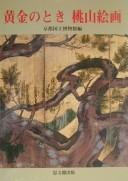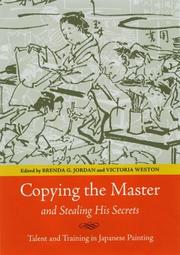| Listing 1 - 7 of 7 |
Sort by
|
Book
ISBN: 9780295991542 0295991542 Year: 2012 Publisher: Seattle University of Washington Press
Abstract | Keywords | Export | Availability | Bookmark
 Loading...
Loading...Choose an application
- Reference Manager
- EndNote
- RefWorks (Direct export to RefWorks)
"Explores the 17th-century consolidation of Japanese painting style by the Kanō artistic house, based on knowledge brought back from China by the monk-painter Sesshü and intertwined with native Japanese practices. Presents key factors in establishing the orthodoxy of the Kanō painters and their role in defining Japanese painting."--Publisher's description.

ISBN: 478421044X Year: 1999 Publisher: 京都 思文閣出版
Abstract | Keywords | Export | Availability | Bookmark
 Loading...
Loading...Choose an application
- Reference Manager
- EndNote
- RefWorks (Direct export to RefWorks)
Kanō School --- Painting, Japanese --- Screen painting, Japanese

ISBN: 0824862007 9780585464111 0585464111 0824826086 Year: 2003 Publisher: Honolulu University of Hawaii press
Abstract | Keywords | Export | Availability | Bookmark
 Loading...
Loading...Choose an application
- Reference Manager
- EndNote
- RefWorks (Direct export to RefWorks)
Copying the Master and Stealing His Secrets examines the transmission of painting traditions in Japan from one generation to the next. The contributors emphasize the relationship between inborn abilities and those skills taught in the course of learning how to paint. They focus their discussion on a group of painting masters loosely associated with the prestigious Kano painting atelier, Japan's de facto painting academy throughout the Tokugawa period (1615-1868) and into the early modern era. By delving into why, how, and what these painters transmitted to students through their teaching, readers gain insight into artistic and aesthetic sensibilities active in Japanese painting and a fuller appreciation of extant paintings within their cultural and historical contexts.
Painting --- Painting, Japanese --- Kanō School. --- Study and teaching --- History. --- Kanō School --- History

ISBN: 0824826086 Year: 2003 Publisher: Honolulu University of Hawaii press
Abstract | Keywords | Export | Availability | Bookmark
 Loading...
Loading...Choose an application
- Reference Manager
- EndNote
- RefWorks (Direct export to RefWorks)
Kanō School --- Painting, Japanese --- Painting --- Study and teaching --- History
Book
Abstract | Keywords | Export | Availability | Bookmark
 Loading...
Loading...Choose an application
- Reference Manager
- EndNote
- RefWorks (Direct export to RefWorks)
Kano School --- Koninklijke Academie voor Teken- en Schilderkunst [Kortrijk] --- anno 1500-1599 --- Japan
Book
ISBN: 9781588396549 Year: 2018 Publisher: New York : New Haven ; London : The Metropolitan Museum of Art, Distributed by Yale University Press
Abstract | Keywords | Export | Availability | Bookmark
 Loading...
Loading...Choose an application
- Reference Manager
- EndNote
- RefWorks (Direct export to RefWorks)
Painting, Japanese --- Painting --- Private collections --- Fishbein, T. Richard, --- Bender, Estelle --- Art collections --- Exhibitions --- Japanese printmaking styles --- Edo [language] --- Japanese [culture or style] --- Heian --- Kano School --- Tosa School
Book
ISBN: 9780300210491 9780876332634 Year: 2015 Publisher: New Haven, CT ; London Philadelphia Yale University Press Philadelphia Museum of art
Abstract | Keywords | Export | Availability | Bookmark
 Loading...
Loading...Choose an application
- Reference Manager
- EndNote
- RefWorks (Direct export to RefWorks)
The Kano lineage of painters--the most important in Japan--was established in the late 15th century by Kano Masanobu (1434-1530) and continued for more than 400 years, until the early 20th century. Originally limited to successive generations of the Kano family, it soon developed into a school of professional artists. This is the first and most comprehensive book published outside of Japan to address the Kano painters. Lavishly illustrated, this important volume focuses on the large-scale screens and sliding doors that were designed for the residences of powerful rulers, together with smaller works such as scrolls, albums, and fans. These works-for sites including shogunate residences, Zen temples, teahouses, and homes of wealthy merchants-demonstrate the range of styles that Kano artists employed to suit the tastes of their varied patrons. Essays by leading scholars address the wide range of Kano motifs and styles and also consider the particular influence of Kano Tan'yu (1602-1684). A dictionary of Kano artists' seals and signatures, a type of resource published here for the first time, provides an important reference, as does an appendix of images from the most significant album by Tan'yu. Exhibition: Philadelphia Museum of Art, USA (14.2.-10.5.2015).
Kanō School --- Painting, Japanese --- Seals (Numismatics) --- Japanese painting --- Nihonga --- History. --- J6230 --- J6015.11 --- Japan: Art and antiquities -- painting and drawing -- Chinese schools --- Japan: Art and antiquities -- musea, exhibitions, collections, fairs in North America -- United States --- History
| Listing 1 - 7 of 7 |
Sort by
|

 Search
Search Feedback
Feedback About UniCat
About UniCat  Help
Help News
News